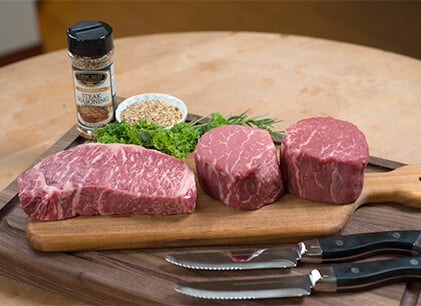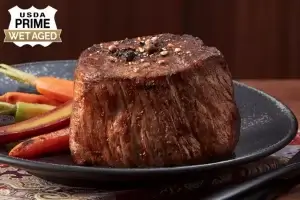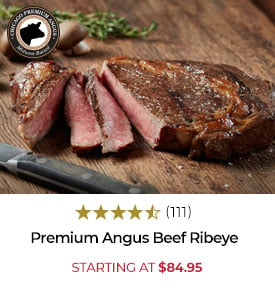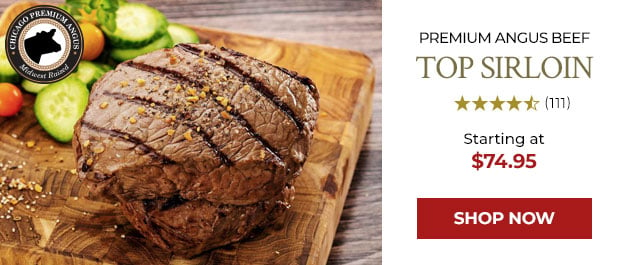
The steak aisle. There’s no doubt we love this section of the local supermarket. But it can also be an overwhelming experience.
What cuts of steak are the best? How can you tell a good cut from a bad one? Are the more expensive cuts really worth the cost? There’s nothing better than a juicy, flavorful grilled steak.
But, the best grilled, fried, or baked steak starts with choosing the best cut. That’s where Steak University can help.
How to Choose the Best Cut of Steak
For just about any steak, it’s especially important to look at thickness. Although thinner cuts of steak can cook just fine on the grill or in the oven, they’re a little more difficult to master. An extra 30 seconds or minute too long, and your delicious steak can turn into a not-so-tempting hockey puck.
Thicker cuts allow you a little more time to play with, so you can get the perfect grill marks and cook without overcooking it. Of course, the right thickness can vary with your preferences, but it’s a good idea to choose a cut that’s at least 1-inch thick for any cooking method.
Then, look at the marbling. See those white lines running through each cut? That’s marbling, which is another name for the fat that runs through the steak, almost like thin veins.
You think you don’t want fat in your steak, right? That’s a common thought, but naturally occurring marbling through the muscle is what gives your steak tenderness and flavor. As it cooks, the fat renders itself down, creating the excellent texture and rich steak flavor you expect.
So, the right amount of fat is a good thing! Of course, you don’t want a fatty steak, so look for nice, thin lines of marbling rather than chunks of fat.
Here comes the tough part – choosing the actual part of the cow! So many cuts are just right for grilling, pan-frying, or baking and experienced grill masters can make just about any steak cook to perfection. But there are a few that we prefer over others for an amazing steak experience, so we’re going to focus on our top picks.
Top Steak Cuts
T-Bone
T-bone steaks are cut from the short loin of a cow, closer toward the stomach than the rear. These cuts are usually tender and one of the most popular at steakhouses because they contain two different types of meat: a tenderloin on one side and a strip steak on the other. So, the T-bone can give you two steak flavors and textures in one cut to please the palate.
Pros
You get two steaks in one with a T-bone, which is quite a treat for any steak lover. T-bones pack a lot of flavors and stay nice and juicy when they’re cooked correctly. T-bones can also be between one and two inches thick, which is just right for the grill, especially.
Cons
The T-bone is on the higher end of the price spectrum compared to other cuts. They’re also difficult to cook since there are two types of meat with different needs on a T-bone.
The best way to cook a T-bone is to sear it over high heat on the grill, and then allow it to finish cooking with indirect heat on the grill. The tenderloin side cooks faster than the strip side since it has less fat, so it can help you to keep the tenderloin side further away from direct flame.
Porterhouse
The porterhouse looks very similar to a T-bone, and that’s because it is. It’s also cut from the short loin and contains both a strip and tenderloin. The difference is that porterhouse steaks tend to be larger than T-bones and a little less tender because they’re cut more toward the legs area, which has more muscle. To classify as a porterhouse, the USDA specifies that the tenderloin portion must have a thickness of at least 1.25” at its widest point.
Pros
Most porterhouses are up to three inches thick, giving you a large, juicy cut with savory flavors. The porterhouse also usually has a larger tenderloin portion than T-bones, both in length and thickness, so you’ll often get a bit more meat from these cuts than a T-bone. Most porterhouse enthusiasts tend to love cooking this cut on a cast iron skillet to give it the perfect sear and control the heat.
Cons
Like the T-bone, porterhouses can be more expensive than other cuts, and often are a bit more per pound than T-bones. Similarly, porterhouses are tricky to cook until you gain some experience with them. But, if you’ve mastered a T-bone on the grill, you can master a porterhouse by cooking it the same way for just a tad longer, depending on thickness. Sear it over high temperatures first and then move it away from direct heat to continue cooking.
Rib Eye
Ribeye steaks are definitely a favorite of ours here at Chicago Steak Company. This cut comes from the prime rib area of the steer – the same area that gives us the prized ribeye cap – and contains incredible ribeye fat content that provides the perfect flavor and texture combination. Ribeyes are usually between ¾ and 1 ½ inches thick, but it’s best to choose a cut closer to 1 ½ inches for the grill to get the perfect cook.
Pros
Ribeyes are super flavorful and can be very tender and juicy when cooked properly. One of the reasons the rib steak great for the grill is because they can cook over the intense flames of the grill and still remain juicy, thanks to their fat content that keeps them tender. Make the most of your rib eye on the grill by searing it for a minute or two on each side over high heat, and then turn down the temperature until it’s cooked to your preference.
The rib steak isn’t necessarily an inexpensive cut, but it is a bit less expensive per pound than most other cuts on this list. You can usually choose a bone-in or boneless cut, with boneless being a little more expensive.
Cons
Because ribeyes have such incredible marbling, you should take extra care when cooking them on the grill. The fat drippings can cause some intense flame flare ups if you’re not careful. Use a drip pan to catch the drippings, or keep your steak away from direct flames. Still, the grill tends to be one of the most popular methods for cooking a ribeye because the smoky flavor lends itself well to the juicy cu
Filet Mignon
The most tender cut of steak is the filet mignon, particularly from Black Angus cattle. This cut comes from the smaller end of the tenderloin and is known for its delicate texture and fine marbling. It’s best cooked quickly on the grill or in a skillet and is ideal when served rare or medium-rare. This cut of steak is one of the most popular, like a royal member of the steak family, if you will.
Pros
Filet mignon cooks beautifully in a pan, especially when wrapped in bacon. Bacon strips give it some extra, robust flavors as they cook along with the steak. Filet mignon is one of the thicker cuts of steak, so it needs a bit more time than other steaks to cook. For best taste and tenderness, sear each side for about four minutes in some butter, and then move the steak and its juices to the oven for about another five minutes at 425-degrees.
Cons
Filet mignon is costly. In fact, it’s usually the most expensive cut of steak. If you’re looking to purchase several pounds of steak for a large cookout, filet mignon may put a bigger dent in your wallet than you intended.
Some people often criticize filet mignon for its lack of flavor compared to other steaks. If you enjoy a beefier flavor, consider using a steak seasoning, bacon strips, gravy, or au jus to flavor your filet mignon – and don’t forget a generous portion of salt and black pepper.
Top Sirloin
Top sirloin steak comes from close to the rear of the animal, right underneath the tenderloin strip portion. This steak isn’t quite as tender as some others, being that it comes from a very muscular area of the animal. But what it does have is some incredible, rich flavors that you won’t find in other steaks. On the grill, a rare to medium-rare cook produces the right balance of flavor and tenderness.
Pros
Top sirloin is highly affordable compared to many other steaks, so it’s great for large cookouts. Still, it provides amazing beef flavor without a lot of fat, making it one of the most perfectly balanced steaks when cooked to the right temperature. Most people prefer to cook top sirloin on the grill because the grill flavor lends itself well to the steak flavor. Brush your top sirloin with some olive oil and your preferred spices before grilling.
Cons
The Top sirloin takes a little more time to cook than other cuts because it’s so muscular. You’ll usually find Top sirloin cut between one and two inches thick. One-inch cuts take about 8 to 12 minutes, and a cut closer to two inches could take more in the 15 to 18-minute range. There’s also little marbling in the Top sirloin, so it can turn tough easily, even if it’s only slightly overdone.
Strip Steak
The strip steak is a cut of beef that comes from the short loin of the animal, right behind the rib area. This area isn’t an especially muscular area, so the cut remains tender.
If you remember, this cut is what makes up one side of the porterhouse and T-bone. The short loin is a large area of the animal, so strip steaks can be quite long and are typically between one and two inches thick. Strip steak comes in boneless or bone-in cuts, with boneless being a bit more costly than bone-in per pound.
Pros
Strip steak is a more affordable cut than T-bone, filet mignon, ribeye, and others. They’re a versatile cut, cooking equally well in the oven, in a pan, or on the grill.
Grilled strip steaks are quite popular, though, since a simple grilling method is all it takes to cook them to perfection. For best results, look for a strip steak about 1 ½-inches thick and season it with some salt and pepper to your liking. Sear each side over high temperature for three to four minutes, and then move to indirect heat for another five minutes or so. A medium-rare cook is perfect for this cut.
Cons
It can be a bit tricky learning how to choose the right strip steak. Since the short loin is such a large area, it includes more tender portions of meat toward the ribs, and some tougher portions toward the loin area. The best trick to learn is to look for strip steaks that are relatively straight, rather than hook-shaped or curved. Straight portions tend to come from the area closer to the ribs, which are usually more tender and have excellent marbling.
Flank Steak
Flank steak is cut from the lower chest or upper abdominal area of a cow. This area is a lean section of the animal, so you shouldn’t need to spend much time trimming off fat. Although flank steak has more connective tissue than some higher-end cuts, it still can become extremely tender and have a lot of flavor when you cook it properly.
Pros
This steak is best to use with marinades that can tenderize the meat muscle that contributes to its naturally tough texture and add a little flavor. Flank is on the thin side and slices easily against the grain, making it an excellent option for a steak sandwich, brisket, fajitas, or stir fry.
Cons
The lean nature of flank steak is good news for those watching fat, but it can also make it challenging to cook this steak cut. Cook it just a bit too long, and you’ll wind up with a chewy texture that doesn’t taste too great either.
Beef Chuck Primal Cut
This cut of meat is a large section of beef cut from the shoulder, arm, and chest sections. With it, you can get other prime cuts, like Denver steak, blade steak, and flavorful roasts. This section of beef is known for its robust flavor and its ability to produce a number of popular steaks.
Pros
Beef that comes from this cut of steak are best used for roasts, where they’ll cook slowly over low heat. The cooking process naturally tenderizes the beef with its own fat, leaving behind the rich, beefy flavor you want without the tough and chewy texture.
Cons
Some steaks that you get from the beef chuck primal cut, like the blade steak, have a long piece of fat running through them that you’ll need to cut around before you eat the meat. Some of these cuts can also be tougher than other steaks you’re used to, so it may not be the best option for searing, cooking on the grill, or using another method that could dry out the beef.
Conclusion: Choosing the Best Cuts of Steak for Every Occasion
We know that, with so many steaks to choose from, the choices can be overwhelming! But Steak University is here to help.
Rest assured that most cooking methods work well for just about any steak cut, with a few special tweaks depending on thickness, cooking temperature preferences, and the type of cut. Whether you want to grill, pan-fry, or broil your steak, practice makes perfect!
For more cooking method tips and information about different types of steaks, check out the helpful articles from Steak University that will get you grilling and searing like a champ.
Can’t decide which cut of steak to get? Why not get them all! Check out Chicago Steak Company’s steak gift assortments for a variety of premium cuts delivered to your door.




